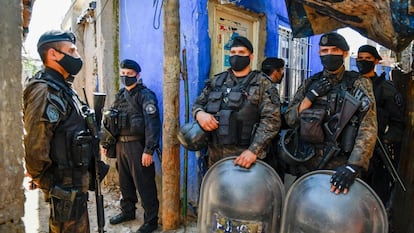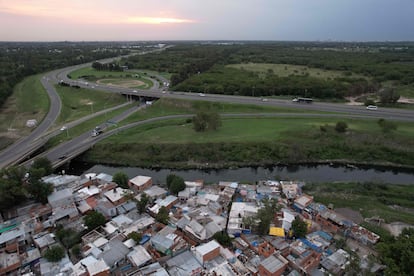Puerta 8: Inside the Buenos Aires settlement where adulterated cocaine killed 24 people
More cases have been detected in the city of Rosario, while Argentine authorities have ordered the deportation of the man accused of distributing the poisoned drug in the capital


Daniel Ramírez speaks slowly. He has a surprising number of scars on his forearms, a memento of cuts he made patiently, in order, parallel to one another. He says that he makes a living by selling cardboard that he collects on the street. Last Tuesday, he took one of the 20,000 doses of adulterated cocaine that have killed at least 24 people in the western outskirts of Buenos Aires. “I consumed it alone and I began to feel dizzy, my eyes clouded over,” he recalls at the door to Carlos Bocalandro Hospital in San Martín, where he has just been discharged. “There are seven or eight who have died taking that cocaine. I have a friend who died because of it. He was called ‘Pata’ and others have felt sick,” he says with an emotionless voice.
Ramírez’s wife has fiery red hair and gesticulates a lot when she talks. “We don’t live in Puerta 8, nowhere near. Puerta 8 is that way,” she says, indicating to the west, “and our home is on the other side, really far away.” No one wants to talk about Puerta 8, the small settlement on the outskirts of Buenos Aires where the adulterated cocaine was sold. When the first deaths occurred, it didn’t take long for police to find the bunker where the drug was “cooked” – officers had been tracking the drug dealers for four months.
Around 200 families live cramped together in the four blocks that make up Puerta 8, which is located between the Buen Ayre highway and the former Route 8 road. The center of Buenos Aires is just over an hour away by car. The streets in Puerta 8 are unpaved and when it rains they turn to mud. In one of the settlement’s tiny streets, a woman is selling fruit and vegetables from a garage. Further down, there is an evangelical church. In Puerta 8, no one says or sees anything.
The fear of the drug cartels is palpable. Puerta 8 is a drug-dealing hub, frequented mostly by people who get by selling cardboard and other recyclable goods. Cocaine here is cheap, less than half the market price. But in exchange, the buyer receives cocaine that is far from pure, typically cut with a harmless powder like Ibuprofen. Last week, however, was different.

According to the authorities in the province of Buenos Aires, the cocaine that has killed at least 24 people was adulterated with a powerful opiate. One of the most widespread hypotheses suggested it was fentanyl, a synthetic opiate that is 25 times stronger than heroin. But preliminary studies have come back negative. Authorities, however, do know that it was an opiate as the patients hospitalized from the drug have responded well to Naloxone, which is used to reverse the effects of opioids. The question is which one: the adulterated cocaine could have been cut with up to 200 different opiates.
Authorities also don’t know why the drug was cut with a product that is more expensive than cocaine in the local market. At first, it was suspected that the adulterated cocaine was linked to a territorial dispute between drug gangs. But this theory was called into question after the poisoned drug appeared in the city of Rosario, which is 300 kilometers north of Buenos Aires. As of Sunday, six people in Rosario had been admitted to hospital after consuming the cocaine, four of whom were in a serious condition.
The victims had bought the cocaine in a neighborhood controlled by Los Monos, a criminal organization that is in charge of the drug trade in Rosario. It’s not known yet whether the cocaine was cut with the same substance used in Buenos Aires. If this is the case, it would indicate that the drug came from the same shipment, meaning the adulterated cocaine is less likely to be the result of a turf war and more likely to be due to a bad mix from the regional provider who supplies the center of Argentina.
In the case of Rosario, the suspected distributor of the adulterated cocaine was arrested within 24 hours, just as Joaquín “El Paisa” Aquino, the alleged owner of the poisoned drug in Buenos Aires, was captured within a day. Once Aquino is no longer of interest to the justice system, he will be deported to his home country of Paraguay, according to Argentina’s National Immigration Department.
Tu suscripción se está usando en otro dispositivo
¿Quieres añadir otro usuario a tu suscripción?
Si continúas leyendo en este dispositivo, no se podrá leer en el otro.
FlechaTu suscripción se está usando en otro dispositivo y solo puedes acceder a EL PAÍS desde un dispositivo a la vez.
Si quieres compartir tu cuenta, cambia tu suscripción a la modalidad Premium, así podrás añadir otro usuario. Cada uno accederá con su propia cuenta de email, lo que os permitirá personalizar vuestra experiencia en EL PAÍS.
¿Tienes una suscripción de empresa? Accede aquí para contratar más cuentas.
En el caso de no saber quién está usando tu cuenta, te recomendamos cambiar tu contraseña aquí.
Si decides continuar compartiendo tu cuenta, este mensaje se mostrará en tu dispositivo y en el de la otra persona que está usando tu cuenta de forma indefinida, afectando a tu experiencia de lectura. Puedes consultar aquí los términos y condiciones de la suscripción digital.
More information
Archived In
Últimas noticias
Trump claims peace in Ukraine is near, but Moscow suggests otherwise
A survivor’s account of the Interoceanic Train accident: ‘We were scared because of the speed on the curve’
The Interoceanic Train, the Mexican alternative to the Panama Canal
What is known about the Interoceanic Train derailment in Oaxaca
Most viewed
- Oona Chaplin: ‘I told James Cameron that I was living in a treehouse and starting a permaculture project with a friend’
- Reinhard Genzel, Nobel laureate in physics: ‘One-minute videos will never give you the truth’
- Why the price of coffee has skyrocketed: from Brazilian plantations to specialty coffee houses
- Pablo Escobar’s hippos: A serious environmental problem, 40 years on
- Chevy Chase, the beloved comedian who was a monster off camera: ‘Not everyone hated him, just the people who’ve worked with him’










































